BUNKER HILLMASSACHUSETTS |
 |
BUNKER HILLMASSACHUSETTS |
 |
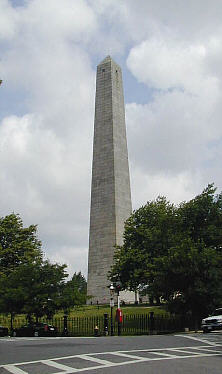 Probably
the most confusing thing about the Battle of Bunker Hill is that it was fought
on Breed’s Hill. Bunker Hill was a larger, more dominant hill in Charlestown,
but the Americans decided to fortify Breed’s Hill instead.
Probably
the most confusing thing about the Battle of Bunker Hill is that it was fought
on Breed’s Hill. Bunker Hill was a larger, more dominant hill in Charlestown,
but the Americans decided to fortify Breed’s Hill instead.
The Bunker Hill monument stands atop Breed’s Hill. The battle was fought here on June 17, 1775, about a month after Lexington and Concord. Between the battles, the citizens of Boston found themselves between two armies. General Artemas Ward’s New England militia surrounded Boston and blockaded the land approaches. General Thomas Gage and about 4,500 British soldiers occupied Boston. On June 15th, the Americans learned that the British planned to occupy Charlestown and gain more control of the hills overlooking Boston.
On the evening of June 16th, Colonel William Prescott, leading 1,200 Massachusetts and Connecticut soldiers chose to fortify Breed's Hill. The next morning, the British awoke to find an earthen redoubt measuring 160 feet by 30 feet on Breed's Hill. Gage immediately ordered his troops to capture the position.
Major General William Howe, Gage's senior officer, was given field command. Howe, after some delay, landed his troops at Charlestown’s point near the mouth of the Mystic River. From here he planned a westward movement across the peninsula to outflank the American redoubt and seize the Charlestown neck.
During the delay, Prescott's men extended their fortifications to the north of the redoubt with more breastworks. When Colonel Stark's New Hampshire men arrived, they joined Connecticut troops in fortifying a rail fence that extended down the slope of Breed's Hill toward the Mystic River. Other soldiers constructed three shelters of fence rails, called fleches, in the exposed area between the breastwork and the rail fence. To cover Prescott's right flank, other men took up sniper positions in deserted Charlestown. In all, about 3,000 New Englanders manned the lines.
It was mid-afternoon when colonial snipers began firing at the arriving Redcoats, Howe ordered immediate retribution and Charlestown was set afire by cannon. As the town burned and spectators crowded the rooftops of Boston to see the spectacle, Howe launched his first assault.
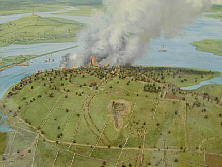
|
The Colonial Army The army which fought at Bunker Hill was a collection of volunteers and free New Englanders. Regiments were made up of militia or minute companies loosely banded together under a colonel. All were hastily organized and untrained. While there were veteran officers about, few had seen a battle, and none had commanded more than a regiment under fire. No trained core of noncommissioned officers yet existed to instill training, drill and discipline. Local loyalties and regional differences prevented an officer from one colony to lead soldiers from another colony. Orders were questioned rather than immediately obeyed. With no trained staff to carry out his orders, General Artemus Ward could rely only upon a vague spirit of cooperation to see his orders obeyed. There were no trained artillerymen, engineers or staff officers. The medical corps was virtually non-existent. Each colony had its own supplies. Being away from home for the first time in most of their lives, most militiamen had no idea how to care for themselves in the field. One officer wrote: “The greatest part of them have not before seen service; and though naturally brave and of good understanding, yet, for want of experience in military life, have but little knowledge of the things most essential to the preservation of health, even life. The youth of America are not possessed of the absolute necessity of cleanliness in their dress and lodging, continual exercise and strict temperance to preserve them from diseases frequently prevailing in camps.” Bunker Hill would prove an invaluable learning experience. The private soldiers had fought exceeding well, but had suffered from their own inexperience and lack of officers. “We have then enough, but want officers,” wrote one soldier, “they are little better than an armed mob. The officers have too little control over their men. And unless a very great change takes place in our camps, we never can face disciplined troops on plain ground.” These were men who could be defeated, but not beaten. The examples shown and the lessons learned would be the first step on the road to Yorktown and victory. (Visitors Center Exhibit) |
Howe's primary object was the rail fence. As a diversion, British General Robert Pigot was to lead an assault on the redoubt and adjoining breastwork, while an elite group of light infantry would proceed up the Mystic shore to outflank the colonials on their left. Simultaneously, Howe and his principal force would hit the defenders of the rail fence.
The advance of the British was an impressive sight to the Americans. But nervous as they were, they had to wait. It was critical that the first rounds of fire be coordinated, with men alternately firing and loading to keep up a barrage capable of breaking the enemy's charge. They were told to wait for the order to fire, to aim low, and to pick off British officers. Legend has it that they were also told to hold fire until they saw the "whites of their eyes."
Interrupting the advance of the British soldiers were fences and uneven terrain hidden by tall grass. Unhindered by such obstacles, the light infantry was able to move swiftly along the Mystic shore, only to be met by Colonel Stark's deadly surprise with troops behind stonewalls on the beach who gave no ground. On the meadow above, Howe's troops approached the Americans and began receiving fire. In the struggle to negotiate fences while under fire, momentum and discipline were lost. The ordered march was broken, the British fell back.
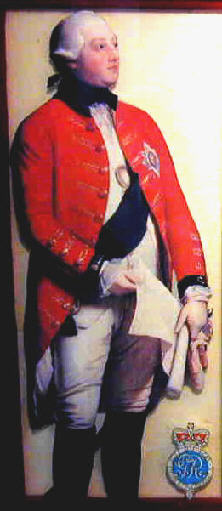 |
The British Army In 1775, the British Army was almost as unpopular a presence at home as it was in the American colonies. Common soldiers, billeted in taverns instead of permanent barracks, were generally resented as ruffians. But these soldiers, the hard-fisted, hard-swearing illiterates, presented a different appearance on the parade-ground. Dressed in dazzling red coats, they drilled with mechanical precision, marching and countermarching to form line, column and square at a steady 75 paces per minute. They were trained to perform these maneuvers with equal accuracy on the battlefield under heavy fire at point-blank range. Initiative training had hardly been heard of; obedience was the chief lesson a recruit had to learn. The American War was one of the worst the British redcoat ever had to fight. Often cold, ragged and half-starved, and 3,000 miles away from home, he fought so well mostly because of his strict training and because of his loyalty to his officers. No battle honors were awarded for the American War. But for sheer courage, the redcoats’ performance at Bunker Hill has hardly ever been equaled. King George III (Visitors Center Exhibit) |
Howe attempted to regroup his troops and ordered a second, even more uncoordinated attack all along the American front. This was also repulsed and the second assault was also a costly British failure.
The American’s were jubilant after repulsing the first two assaults. However, they were running out of ammunition and they lacked reinforcements. They were not prepared for another determined assault.
But once again, the British regrouped. In the final assault, they drove against the right and center of the American line. They cut through the breastwork and overran the redoubt from three sides. Stark managed to hold on at the rail fence long enough to help cover Prescott's retreat, but the final scene inside the redoubt was gruesome.
The surviving colonials retreated northward toward Cambridge. The British, bloodied and exhausted, pursued only as far as Bunker Hill and there dug in. By evening, the fighting was over.
Both armies had fought courageously. Although the British had won the day, out of 2,200 soldiers engaged, about half were casualties. The Americans suffered about 500 casualties. The British attempted no further actions outside Boston until they were threatened by the placement of Henry Knox’s artillery about nine months later.
As a result of the Battle of Bunker Hill, the Americans had shown that they could seriously engage the British in the defense of the areas surrounding Boston. Bunker Hill was a costly victory for the British. General William Howe, who replaced Gage as the British military commander, had gained a new respect for the stubbornness and determinacy of the colonial forces. In the Revolutionary War engagements that followed, he would use much too much caution in his battle plans and engagements against the Americans. He would eventually be replaced, too late, by Lord Charles Cornwallis.
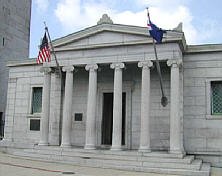 Today,
the Bunker Hill Monument stands atop Breed’s Hill to commemorate the battle.
The Bunker Hill Monument Association was incorporated in 1823 for the purpose of
purchasing the battlegrounds and constructing on the site a suitable memorial.
On June 17, 1843, with Daniel Webster as orator, the completed monument was
dedicated.
Today,
the Bunker Hill Monument stands atop Breed’s Hill to commemorate the battle.
The Bunker Hill Monument Association was incorporated in 1823 for the purpose of
purchasing the battlegrounds and constructing on the site a suitable memorial.
On June 17, 1843, with Daniel Webster as orator, the completed monument was
dedicated.
The association maintained the monument and grounds until 1919 when it was turned over to the Commonwealth of Massachusetts. In 1976 the Bunker Hill Monument was transferred to the National Park Service and became a unit of Boston National Historical Park.
The Bunker Hill Monument is open daily, except Thanksgiving, Christmas and New Year's Day. Park Rangers are on duty to assist visitors and answer questions. The 294 step climb to the top of the monument is recommended on a longer visit to the area.

| Freedom Trail - The Freedom Trail is a
walking trail that connects the Revolutionary War
history of Boston with the city itself. A walk on the trail from
Bunker Hill to the Boston Common passes through the varied neighborhoods
that characterize the city. The trail is marked by red bricks or a
red-painted line and can easily be followed except for occasional
obstacles along the way. The walk is about three miles long and can easily
be completed in an hour. There are many stops along the way and a return
visit is recommended to see them all.
|
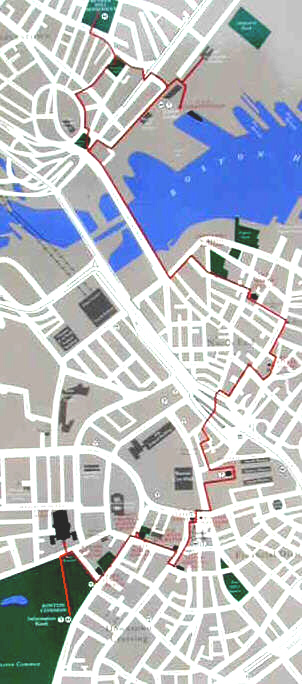
|
